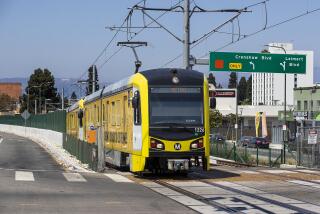Think Bigger, NIMBYs
People are sick of long commutes. Even in this land of backyard barbecues, demand is growing for a more urban lifestyle, for apartments above shops and cafes, for neighborhoods where residents can walk to the store and jump on a light-rail line to get to work.
Or so said planners at Tuesday’s Mobility 21 summit, an assembly of government, business, academic and community leaders trying to keep Los Angeles County from coagulating into one massive traffic jam. One entire workshop was devoted to building housing along transit lines.
That same day, owners of houses along one of the region’s newest transit lines delivered the opposite message. To hear some residents describe it, South Pasadena was close to idyllic until Gold Line trains started rumbling, squealing and clanging through town last year. The downtown-to-Pasadena light-rail line, they say, has destroyed their suburban Eden.
“We don’t want to be L.A.,” grumbled one City Councilman.
News flash: South Pasadena was already a congested urban community and part of a mammoth metropolis of almost 10 million when the Gold Line began operation.
South Pasadena is not alone, either in its opposition to mass transit or its fantasy that it’s an island rather than part of a still-growing metro area. In the San Fernando Valley, residents are continuing their court battle to stop the Orange Line, an east-west busway that’s already 30% complete. In Cheviot Hills, neighbors have for decades blocked construction of a light-rail line between Santa Monica and downtown along a right of way already in public hands.
The Mobility 21 coalition was formed to rally California’s notoriously fractured congressional delegation to wrest more money for key Southern California projects, including more carpool lanes and a Green Line link to Los Angeles International Airport. But for the money to make any difference, the folks at home also need galvanizing. We have seen gridlock, and it is us.
Southern Californians often point to cities like San Francisco and Munich, Germany, as more livable than Los Angeles, precisely because they have good public transit systems. Well, like everything else in life, there’s a trade-off.
Planners can increase community support by working to address as many noise, safety and design concerns as possible, of course. But those who live next to a transit line (and surely bought their houses knowing about the rail right of way) need to recognize that the trade-off for bells and brakes is eased congestion, cleaner air and a more workable city. And those who long for easier commutes need to make sure their voices are heard amid the noisier opposition.
More to Read
Sign up for Essential California
The most important California stories and recommendations in your inbox every morning.
You may occasionally receive promotional content from the Los Angeles Times.










